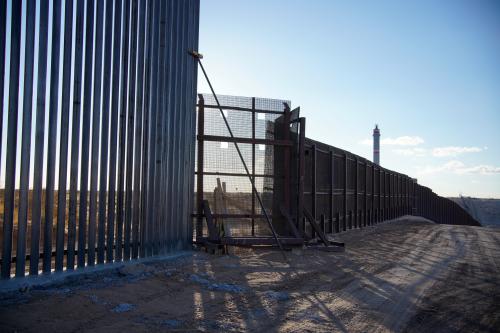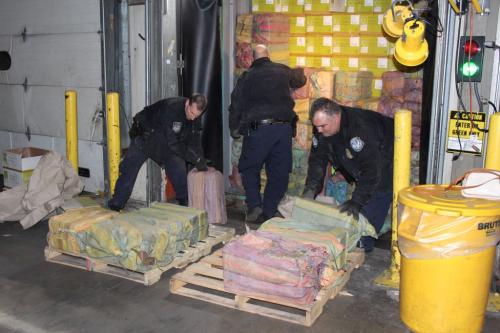On February 11, 2019, Vanda Felbab-Brown submitted to members of the U.S. Congress a statement for the record on border security and comprehensive immigration reform.
Senator Casey and members of U.S. Congress:
I am honored to have this opportunity to submit a statement for the record for the field hearing on the important issue of border security and immigration reform. I was asked to comment on the role impact a border wall and other border security measures on drug smuggling into the United States—the principal subject of my testimony below. I would be remiss, however, not to address also the impact of a border barrier on U.S. native communities and U.S. biodiversity. Trafficking, its nexus with security, and policies to counter them are the subject of my work at the Brookings Institution where I am a senior fellow. In my Brookings essay “The Wall,” I assess in detail the many effects of a border wall or physical barrier also on other subjects, including criminality and jobs in the United States and migration to the United States.1 My testimony below represents my personal views only and does not reflect the views of The Brookings Institution, its other scholars, employees, officers, and/or trustees. As an independent think tank, The Brookings Institution does not take institutional positions on any issue.
A wall or a physical barrier on the U.S. border with Mexico will not significantly reduce drug flows to the United States. However, while essentially irrelevant for affecting drug flows to the United States, a physical barrier, including a see-through metal structure, comes with significant financial resource and counterproductive side-effects. Even from the very narrow perspective of countering drug smuggling, the financial resources for a border wall could be far more meaningfully devoted to other counternarcotics means, such as improvements to legal ports of entry along the border and support for the U.S. Coast Guard.
How Traffickers Can and Do Counter a Physical Barrier at the U.S.-Mexican Border
Any kind of a border physical barrier can be countered by certain contraband smuggling methods, even if the barrier is at least six feet deep and 30 feet tall (as the Department of Homeland Security requested in its specifications for border barrier prototypes). Drug traffickers can—and already do—employ a variety of methods to thwart such physical border barriers. These include:
Tunnels
An obvious response by smugglers to a border barrier is tunnels. Already, drug smugglers are using tunnels to get drugs into the United States, a method pioneered by Mexico’s most notorious drug trafficker, Joaquin “El Chapo” Guzmán, now on trial in the United Sates. Many of these tunnels do not run merely under existing border barriers. Rather, they connect buildings in border cities in the United States and Mexico. The longest such drug tunnel discovered so far ran from Tijuana to San Diego over more than half a mile and was equipped with ventilation vents, rails, and electricity. It was the thirteenth tunnel of such considerable length and sophistication discovered since 2006.2 Between 1990 and 2016, 224 tunnels were discovered at the U.S.-Mexico border.3 Joint drainage systems between border towns are also utilized to smuggled drugs.
Airborne Smuggling
Other smuggling methods increasingly include the use of drones4 and catapults. Drones are currently limited in their payload, i.e., the amount of cargo they can carry, and thus are not an efficient drug smuggling method for most drugs. However, over time, payload capacities will improve, also facilitating drug smuggling. Moreover, the payload limitations can be overcome by flying a larger number of drones. And for high-potency high-profit drugs, such as fentanyl, even a small payload can generate substantial profits. Historically, small aircraft have been used to traffic drugs by landing in remote areas. A physical barrier is irrelevant for any airborne-drug smuggling.
Seaborne Smuggling
Smuggling drugs by sea is another time-tested and obvious method. Boats carrying drugs can land along the U.S. coast. If the U.S.-Mexico land border were in fact tightened, the trend toward smuggling further north into the California coast would only intensify. For that reason—and more importantly, to prevent the possibility of far more dangerous terrorist attacks in U.S. ports—cutting the U.S. Coast Guard’s budget, as the Trump administration at one point proposed to pay for the wall, is counterproductive.5 The U.S. Coast Guard is a vital aspect of U.S. border security, countering many dangerous threats such as terrorism and illegal fishing.
Many drugs are smuggled into the United States through legal sea ports, such as Miami and Los Angeles, but also as far north as Boston. Drugs smuggled through seaports are hidden in legal cargo—for example, fish or toys—and never cross the U.S.-Mexico land border. A physical border barrier on the U.S.-Mexican border will not prevent these flows. If a wall or barrier were to be at all effective (a most unlikely outcome), it would only encourage greater utilization of such smuggling methods.
Legal Ports of Entry
Crucially, highly valuable drugs—namely, cocaine, heroin, synthetic opioids such as fentanyl, and methamphetamines—are not smuggled on the backs of those who cross illegally.
According to the U.S. Drug Enforcement Administration, hard drugs coming into the United States across the U.S.-Mexican border are smuggled into the United States through the 52 legal ports of entry on the border6 which have to process millions of people, cars, trucks, and trains weekly. Traffickers hide their illicit cargo in hidden and increasingly sophisticated special compartments in cars or under legal goods in trailer trucks, of which 5,042,062 have crossed the U.S.-Mexico border annually since 2006, in other words some 13,800 daily.7
Realizing that the border cannot be simply sealed and that checking every article that crosses the border is infeasible, the Obama administration sought to modernize legal ports of entry. This so-called “21st century border” element of the Beyond Merida Initiative included building container inspections away from the border, deeper in Mexican territory. One such joint U.S.-Mexican secure container inspection site has been operating in the Mexican state of Michoácan, a major producer of agricultural goods, such as avocados. Agricultural products in particular are vulnerable to spoiling during lengthy inspection wait times at the border. Joint inspection sites away from the border reduce the amount of cargo containers that need to be inspected at the border, thus allowing more time for customs officials at the border to concentrate on goods and personal vehicles that have not been checked away from the border before.
Postal and Mailing Services
Drugs that have a high-potency to weight ratio, such as synthetic drugs like fentanyl, can also be shipped to the United States directly from producers. Indeed, much of the deadly fentanyl and its analogues is mailed that way from China to the United States. Since drug flows never cross the U.S.-Mexican land border, they will not be affected by a wall.
Misdirected Claim: Undocumented Migrants and Drugs
Allegations that undocumented migrants carry illegal drugs into the United States are exaggerated and misdirected. Some years ago, Mexican trafficking organizations did force undocumented migrants, whom they subjected to violence and abuse in Mexico, to carry marijuana across the border. However, this trend has since significantly abated for several reasons. The drug-trafficking organization most associated with this type of cannabis smuggling, the Zetas, has been disrupted in Mexico as a result of joint U.S.-Mexican cooperation. The Zetas have fragmented into smaller criminal outfits with lesser territorial presence in Mexico. Many migrants seeking to cross the U.S.-Mexican border over the past three years have not attempted to cross illegally; instead they have handed themselves over to U.S. agents and requested asylum. Asylum seekers do not carry cannabis. Before legalization of cannabis by various U.S. states, Mexican drug trafficking groups began to illegally cultivate cannabis in the United States, such as in California’s federal and state parks, thus often causing extensive environmental damage. The legalization of recreational cannabis by many U.S. states has rendered the smuggling of cannabis into the United States non-lucrative.
Dangerous Flows from the United States to Mexico
The U.S. demand for illegal drugs stimulates the illegal production of drugs abroad, including in Mexico.
Contraband also crosses the border from the United States to Mexico. Billions of dollars are made in the illegal retail drug market in the United States and smuggled back to Mexico. Sometimes, sophisticated money-laundering schemes, such as trade-based deals, are used. Other times, large parts of the proceeds are smuggled as bulk cash in cars, trains, hidden among goods or by mail, financing basic daily operations of the cartels. Yet U.S. Customs and Border Protection officers have the capacity to check only a small portion of flows heading south. A wall will not affect these cash flows; better technological equipment at the U.S.-Mexican border could reduce them.
Similarly, about 70 percent of firearms seized in Mexico between 2009 and 2014, amounting to some 73,000 guns, originated in the United States.8 The captured weapons are likely only a small percentage of the weapons trafficked from the United States to Mexico.
U.S.-Mexican Border Security Cooperation
The George W. Bush administration and the Obama administration recognized the joint responsibility for drug trafficking between the United States and Mexico, an attitude that allowed for unprecedented security and anti-crime collaboration between Mexico and the United States. Expressed in the Merida Initiative and the Beyond Merida phase of the Initiative, this collaboration allowed U.S. law enforcement and intelligence agents to operate in Mexico and help their Mexican counterparts in intelligence development, training, security institution building, and interdiction operations. The collaboration also led to unprecedented Mexican willingness to patrol its northern border with the United States. That collaboration, including crucially in the counterterrorism domain, is far more important for U.S. security than any wall.
Negative Side Effects of a Physical Barrier on Indigenous Communities and the Environment
However, a border wall or a physical barrier will not merely be ineffective with respect to stopping the flow of drugs. It will come with significant counterproductive social costs and human rights violations and cause extensive and potentially irretrievable environmental damage.
Twenty-six federally-recognized Native American Nations and eight Indigenous Peoples in Mexico live around the U.S.-Mexico border, including the Tohono O’odham and Pascua Yaqui of Arizona, Kickapoo and Lipan Apache (also known as the Nde’) of Texas, and Kumeyaay of California. The border cuts through the tribal homelands and communities of Native Nations, separating members from their relatives, traditional homelands, sacred sites, and the natural environment on which they rely for livelihoods and depend on for cultural and religious fulfillment and their of cultural and linguistic identity. In 1983, the U.S. Congress passed an act allowing Kickapoo tribal members in southern Texas and the Tohono O’odham in southern Arizona to travel across the border within their homeland.9 The Tohono O’odham tribe is also the sole U.S. recognized tribe that enrolls Mexican members.
Yet the existing fence and the proposed wall seriously compromise these community connections. The fence has complicated collecting and transporting traditional foods, and visiting family members and sacred sites. The Tohono O’odham tribal leaders have repeatedly objected to the construction of the wall,10 noting threats to wildlife and damage to ancestral burial sites and other sacred places.11 In order to build the existing fence, the Department of Homeland Security (DHS) in 2005 waived in their entirety the National Historic Preservation Act as well as the Texan Native American Grave Protection and Repatriation Act 1990, and the American Indian Religious Freedom Act 1994. All of the border tribes have also suffered significant, if compensated, land seizure so that the fence could be built.
Ironically, it was U.S. border enforcement decisions in the 1990s, such as Operations Hold the Line (1993), Gatekeeper in San Diego (1994), Safeguard (1995), and Rio Grande (1997), designed to increase security at border crossing areas, which drove trafficking and undocumented migration away from cities and into the difficult desert and rural terrain. That law enforcement strategy brought intense drug trafficking into the tribal lands of Native Nations. The O’odham reservation that spans 75 miles (about 20 percent) of the Arizona-Mexico border, became the second-largest smuggling corridor.12 The impact on native populations has been severe. The relocation of illicit flows exhausted tribal law enforcement and medical facilities, eventually bringing federal immigration law enforcement agents into tribal lands in often disruptive and confrontational ways and without adequate consultation with13 and agreement from the O’odham tribe, despite the tribe’s special legal status regarding law enforcement.14
Moreover, the relocation of drug and people smuggling to Native American lands also ensnarled indigenous communities in the trafficking. The indigenous communities on both sides of the border exhibit significantly lower living standards and higher poverty rates than the rest of the U.S. population. With unemployment among the 28,000 tribal members hovering around 40 percent and about 40 percent living below poverty line with a per capita income of about $8000,15 some tribal members became susceptible to being recruited for smuggling drugs or driving undocumented migrants further into the United States. Outside traffickers sometimes also resorted to violence.
The Native American communities need protection and multifaceted support. However, they object to a wall or a physical barrier that would tear their communities apart. Their voices need to be recognized in border security measures.
Like Native American communities, conservation biologists, and the U.S. Fish and Wildlife Service16 contend that the wall will also have significant environmental costs. Parts of the border known as “Sky Islands” are some of the continent’s most significant wildlife corridors. What makes those areas so special is the unusual convergence of four major ecoregions: the southern terminus of the temperate Rocky Mountains; the eastern extent of the low-elevation Sonoran Desert; the northern edge of the subtropical Sierra Madre Occidental; and the Western terminus of the higher-elevation Chihuahuan Desert.17 This overlap of ecosystems gives rise to unique species as well as creates vital migration routes for the fauna.
Among the endangered species affected by the wall would be the jaguar, the Sonoran pronghorn, and Chiricahua leopard frog, lesser long-nose bat, Cactus ferruginous pygmy-owl, Mexican gray wolf, black-tailed prairie dog, jaguarondi, ocelot, and American bison.18 The other many negatively-affected species will include desert tortoise, black bear, desert mule deer, and a variety of snakes.19 But even species that can fly, such as Rufous hummingbirds and Swainson and Gray hawks could be harmed. Vital pollinators that migrate across the border, such as insects, could be burnt up by the lights necessary to illuminate the wall.20
Rare and endangered species also occur in the Southwest beyond the Sky Islands, particularly in the Big Bend National Park21 in Texas and in the Rio Grande Valley. Altogether, more than 100 species of animals that occur along the U.S.-Mexico border are endangered or threatened. They are and should be accorded special protections, and it is imperative that we make every effort to preserve healthy survival of these species. Yet in order to build the fence, the DHS waived not only cultural protection statutes, but also many crucial environmental laws—namely, the Endangered Species Act 1982, the Migratory Bird Treaty Act 1916; National Environmental Policy Act 1982; Coastal Zone Management Act 1972; and the Clean Water Act 1999. The existing fence was not built in some of the most sensitive ecological areas. The Trump administration, however, seeks to override these environmental concerns, selecting some of the most sensitive environmental areas, such as the Texas Butterfly Sanctuary, to build border barriers regardless of their immense and vastly damaging environmental consequences.
The Trump administration thus threatens years of efforts to develop cooperative and inclusive environmental programs at the border—in which Indigenous Nations have participated along with state and local governments—such as the binational Border 2020 program, overseen by the U.S. Environmental Protection Agency and Mexico’s Secretariat for the Environment and Natural Resources.
Recommendations
Rather than investing in a costly and ineffective border wall or a physical barrier, the United States should adopt the following measures to improve border security and mitigate drug trafficking:
- Improve infrastructure and deploy extensive contraband-detecting technologies at legal ports of entry and U.S. mail and courier service centers;
- Provide adequate funding for the U.S. Coast Guard;
- Enhance the deployment of remote technology along the U.S.-Mexican border, including anti-drone technologies;
- Build further U.S.-Mexican off-border border inspections sites with embedded U.S. personnel, diligent vetting of all Mexican and U.S. personnel during recruitment and at any point subsequently, the facilities to be equipped with constant and comprehensive CCTV coverage with live feed to monitors in the United States;
- Provide greater resources for U.S. Customs and Border Patrol officials, coupling such resources with diligent and extensive training and vetting of such personnel not just at recruitment but throughout their careers;
- Collaborate with the Government of Mexico in countering drug trafficking through joint intelligence sharing and improved ways to counter drug trafficking groups and violent crime;
- Recognize and respect voices of Native American communities in border security design; and
- Protect U.S. natural heritage and biodiversity in designing border security measures, by integrating comprehensive environmental assessments into all border security policies, placing limitations on, and denying funding for any border barriers that compromise protected areas and threatened or endangered species and U.S. biodiversity overall.
-
Footnotes
- Vanda Felbab- Brown, “The Wall: The Real Costs of a Barrier between the United States and Mexico,” The Brookings Institution, August 2017, https://www.brookings.edu/essay/the-wall-the-real-costs-of-a-barrier-between-the-united-states-and-mexico/
- Nick Allen, “Longest Drug Trafficking Tunnel Found between Mexico and the United States,” The Telegraph, April 21, 2016, http://www.telegraph.co.uk/news/2016/04/21/800-yard-long-drug-tunnel-found-between-mexico-and-united-states/
- Ioan Grillo, “Mexican Drug Smugglers to Trump: Thanks,” New York Times, May 5, 2017.
- Vanda Felbab-Brown, “Drugs and Drones: The Crime Empire Strikes Back,” The Brookings Institution, February 24, 2016, https://www.brookings.edu/blog/order-from-chaos/2016/02/24/drugs-and-drones-the-crime-empire-strikes-back/.
- Dan Lamothe, Ashley Halsey III, and Lisa Rein, “To Fund Border Wall, Trump Administration Weighs Cuts to Coast Guard, Airport Security,” Washington Post, March 7, 2017.
- Drug Enforcement Administration, “2015 National Drug Threat Assessment,” October 1, 2015, https://www.dea.gov/sites/default/files/2018-07/2015%20NDTA%20Report.pdf.
- Bureau of Transportation Statistics, https://transborder.bts.gov/programs/international/transborder/TBDR_BC/TBDR_BCTSA.html.
- U.S. Government Accountability Office, “Report to Congressional Requesters: Firearms Trafficking – U.S. Efforts to Combat Firearms Trafficking to Mexico Have Improved, but Some Collaboration Challenges Remain,” GAO-16-223, January 2016, http://www.gao.gov/assets/680/674570.pdf.
- Rachel Marchbanks, “The Borderline: Indigenous Communities on the International Frontier,” 26(3), Spring 2015, http://tribalcollegejournal.org/borderline-indigenous-communities-international-frontier/
- Laurel Morales, “Border Wall Would Cut Across Land Sacred to Native Tribe,” NPR.org, February 23, 2017, http://www.npr.org/2017/02/23/516477313/border-wall-would-cut-across-land-sacred-to-native-tribe
- Testimony of the Honorable Ted Norris, Jr., Chairman, Tohono O’odham Nation to the Subcommittee on Fisheries, Wildlife, and Oceans, and Subcommittee on National Parks, Forests, and Public Lands of the House Committee on Natural Resources, Joint Oversight Hearing “Walls and Waivers: Expedited Construction of the Southern Border Wall and Collateral Impacts to Communities and the Environment, April 28, 2008, http://www.tiamatpublications.com/docs/testimony_norris.pdf.
- John Dougherty, “One Nation, Under Fire,” High Country News, February 19, 2007, http://www.hcn.org/issues/340/16834.
- Rachel Starks and Adrian Quijada, “Indigenous Peoples and the U.S.—Mexico Border Wall,” in C.A. de la Parra, A. Córdova, and E. Peters, eds., Border Wall: Venues, Mechanisms and Stakeholders for a Constructive Dialogue Between the United States and Mexico (INE/EI Colegio de la Frontera Norte: 2016): 45-56.
- U.S. Government Accountability Office, “Report to the Honorable Jon Tester, U.S. Senate: Border Security – Partnership Agreements and Enhanced Oversight Could Strengthen Coordination of Efforts on Indian Reservations,” GAO-13-352, http://www.gao.gov/assets/660/653590.pdf.
- Dougherty.
- Darryl Fears, “Endangered Animals Are Already Cut off by a Border Wall,” Washington Post, January 27, 2017.
- Kim Vacarin and Jenny Neeley, “Ecological Considerations for Border Security Operations: Outcomes and Recommendations of the Border Ecological Symposium, Tuscan, Arizona, March 9-10, 2005,” Defenders of Wildlife, http://www.defenders.org/sites/default/files/publications/march_2005_border_ecological_symposium.pdf.
- Vacarin and Neeley.
- Fears.
- Tim Gaynor, “U.S.-Mexico Border Fence May Harm Animal Migration,” Reuters.com, http://www.banderasnews.com/0609/eden-animalmigration.htm.
- Heather Hansman, “Paddling with a Passport from the U.S. to Mexico,” National Geographic April 26, 2017, http://www.nationalgeographic.com/adventure/destinations/united-states/texas/big-bend-national-park/paddling-rafting-big-bend-national-park-mexico/.










Commentary
TestimonyBorder security and comprehensive immigration reform
February 11, 2019